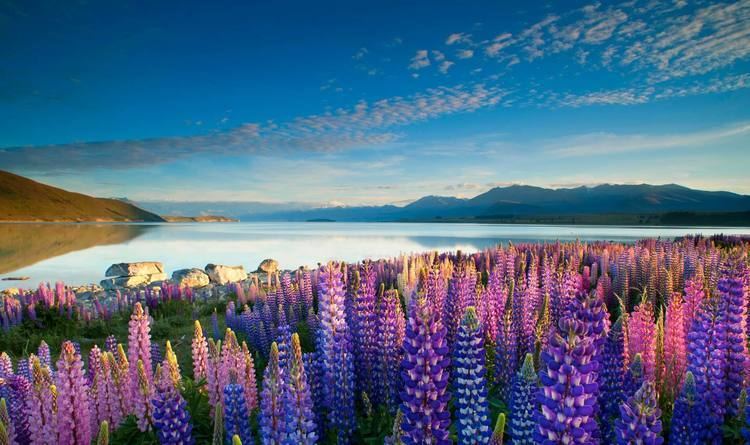Basin countries New Zealand Local time Sunday 6:08 AM | Catchment area 1,463 km (565 sq mi) Max. length 27 km (17 mi) | |
 | ||
Primary inflows Weather 8°C, Wind E at 6 km/h, 97% Humidity Points of interest Church of the Good Shepherd, Roundhill Ski Area, Sheepdog Statue | ||
Lake Tekapo is the second-largest of three roughly parallel lakes running north–south along the northern edge of the Mackenzie Basin in the South Island of New Zealand (the others are Lake Pukaki and Lake Ohau). It covers an area of 83 square kilometres (32 sq mi), and is at an altitude of 710 metres (2,330 ft) above sea level.
Contents
- Map of Lake Tekapo 7999 New Zealand
- Hydroelectricity
- Church of the Good Shepherd
- Bronze sheepdog
- References
Map of Lake Tekapo 7999, New Zealand
The lake is fed at its northern end by the braided Godley River, which has its source in the Southern Alps to the north. The lake is a popular tourist destination, and several resort hotels are located at the township of Lake Tekapo at the lake's southern end. The Lake Tekapo Regional Park, administered by Environment Canterbury, is located on the southern shore of the lake.
An astronomical observatory is located at Mount John, which is to the north of the town, and south of the small Lake Alexandrina.
Hydroelectricity
The lake's original outflow was at its southern end, into the Tekapo River. In 1938 construction commenced on a power station, originally due to be finished in 1943 but halted in 1942 by the world war. At the same time, control gates were constructed to regulate outflows to the Waitaki Dam downstream. Work restarted in 1944, and the power station now known as "Tekapo A" came online in 1951.
Water from the lake is diverted through a 1.4-kilometre (4,600 ft) tunnel under the town to the power station, with the water originally being returned to the river. With development of the Upper Waitaki hydroelectric scheme in the 1970s, water is now fed into a 26-kilometre (16 mi) canal which leads to Tekapo B on the shores of Lake Pukaki.
Following a turbine failure in 1986, a new Kaplan turbine was installed, with a more efficient design and higher output (42 000 HP) than the original. Today, the power station produces an average of 160 GWh annually, from a 25.2 MW capacity generator. The net head of the station is 30.5 m.
In 2008 Tekapo A and Tekapo B hydro stations were refurbished following the upgrade of Benmore and Waitaki.
On 1 June 2011, Tekapo A and B hydro power stations were transferred from Meridian Energy to Genesis Energy on instruction from the Government.
Church of the Good Shepherd
Situated on the shores of Lake Tekapo is the Church of the Good Shepherd, which, in 1935, was the first church built in the Mackenzie Basin. The church at Burkes Pass, St Patrick's built in 1872 was the first church built by pioneers as a joint community effort, by Anglicans Presbyterian and Catholic settlers. Also a joint venture between Presbyterians and Anglicans, St Columba in Fairlie was built in 1879. The church at Lake Tekapo was designed by Christchurch architect R.S.D. Harman, based on sketches by a local artist, Esther Hope. The church is arguably one of the most photographed in New Zealand, and features an altar window that frames stunning views of the lake and mountains.
Bronze sheepdog
Close to the Church of the Good Shepherd is a well-known bronze statue of a New Zealand Collie sheepdog. The statue was commissioned by Mackenzie Country residents in recognition of the indispensable role of the sheepdog in their livelihoods. The sculptor was Innes Elliott of Kaikoura, with a dog called Haig, belonging to a neighbour, being the model. Elliott reported the sculpting process took approximately fifteen months. Clay for the model came from the insulator works in Temuka, with a plaster cast of it made and sent to London in 1966, where the statue was cast.
